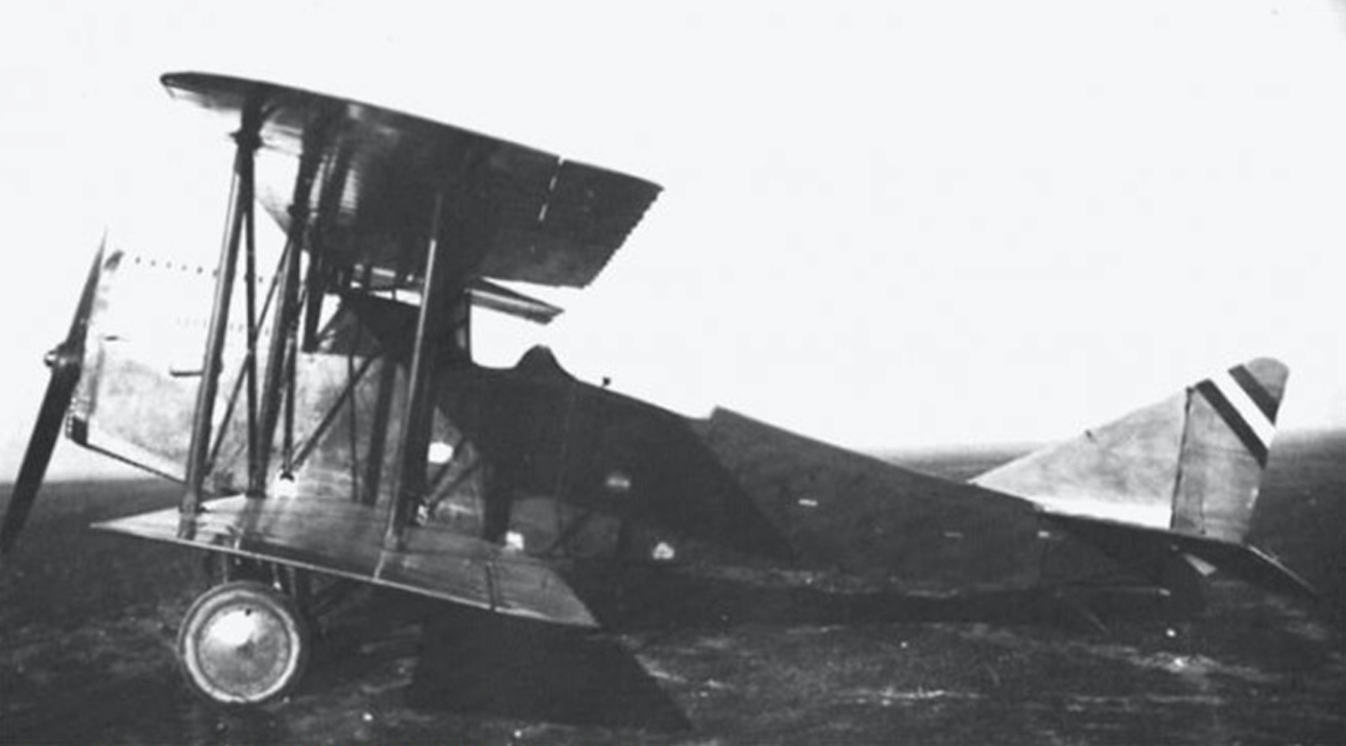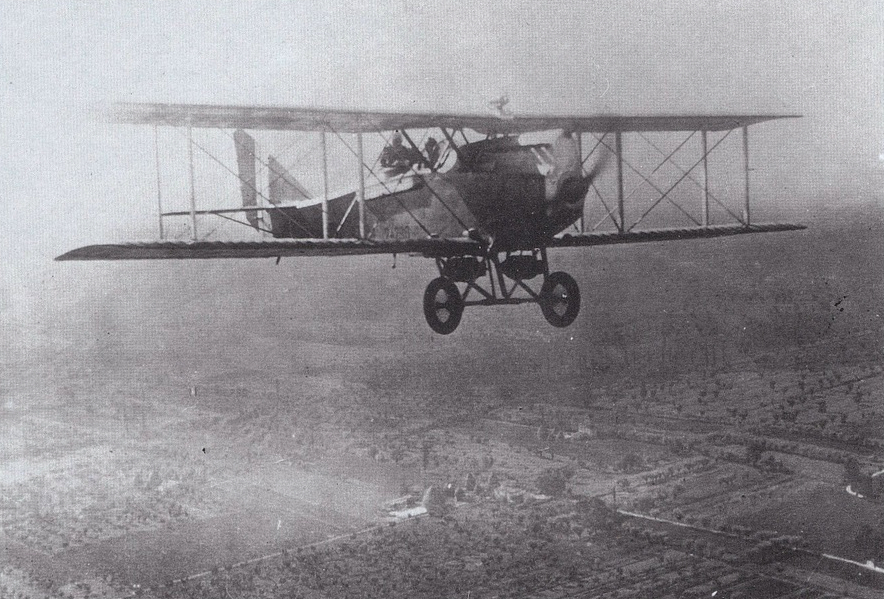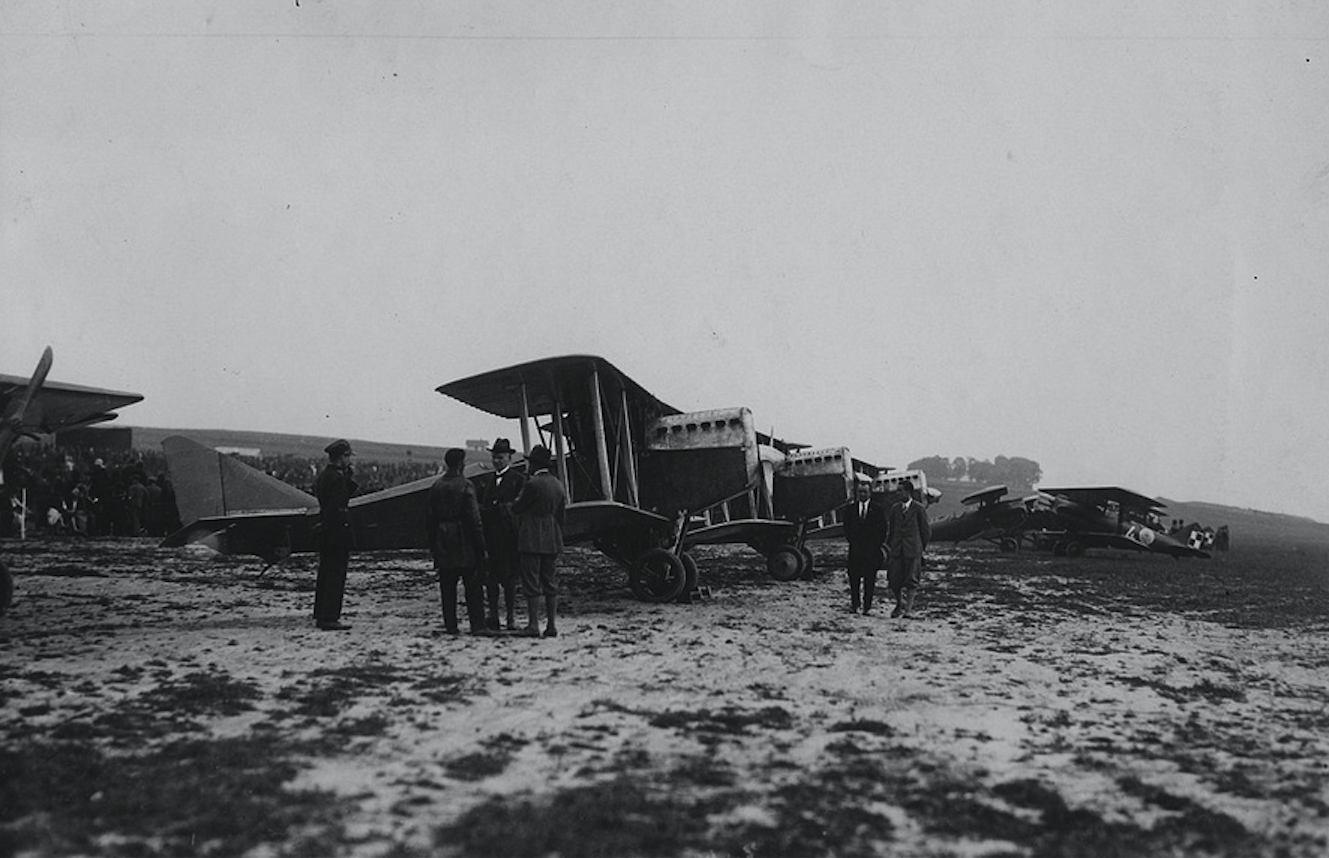Kraków 2017-12-30
History
00120c Section 1920 year.
Ansaldo A-300 in Poland.



In 1918, the great world war was still going on, when engineer Emilio Verduzzio developed a design for a new intelligence-bomber at the Gio Ansaldo aviation plant in Turin. Some sources incorrectly give the city of Genoa the origin. It must be remembered that the Ansaldo concern operated mainly in the shipbuilding industry and had the largest shipyard in Genoa. On the other hand, planes and cars were built in Turin.
An intelligence-bomber plane is a type of flying apparatus that was born in the first years of the war. The plane has a two-man crew, which, apart from the pilot, was also a commander-observer, a shooter, bombardier and a photographer. In Poland, this type was referred to as a linear plane.
The new aircraft was designated Ansaldo A-300, and the design is derived from the Ansaldo SVA-9 / Ansaldo SVA-10 aircraft. The Ansaldo A-300 camera differed from its predecessors mainly in a more powerful engine. The plane uses a 300 HP FIAT engine and therefore the number 300 appears in the name. Like all Gio Ansaldo airplanes, the airplane was built almost entirely of wood. The hull structure consists of wooden frames and stringers covered with plywood, 2 mm thick. To the front frame there is a metal engine mount, adapted to the installation of an in-line engine with a liquid cooling system and a radiator. The front of the fuselage is covered with an aluminum hood. In the fuselage, the pilot's cabin and the rear observer's cabin were placed in the front.
The wings are double-winged, of wooden structure, double-spar, covered with canvas. The wing profile is concave-convex, also called avian. The outline of the lobes is rectangular. The sheets are stiffened with stands made of steel tubes with a drop section and steel ties.
The Ansaldo A-300 aircraft did not have time to take part in the war. Mass production started in the summer of 1919. In September 1919, the plane was shown at an exhibition in Amsterdam because the plane was mainly offered to foreign customers. Returning from the exhibition to Italy, the plane visited Poland. The camera was demonstrated in Poznań, Warsaw and Kraków.
Initially, the Ansaldo A-300-2 two-seater version was produced, and then in 1920, a series of Ansaldo A-300-3 (Ter) three-seater aircraft was built. The Italian air force adopted approximately 90 Ansaldo A-300-3 (Ter) machines. The second cabin on this plane was elongated and housed the observer and the gunner. The three-seater versions were relatively popular in Italian aviation, but mainly two-seater were exported.
After 1922, versions -4, -5, -6 were created. About 700 Ansaldo A-300 aircraft were built.
Ansaldo A-300 intelligence-bomber aircraft were used in the aviation of Italy, Belgium, Spain, Hungary, Turkey and Poland.
Ansaldo A-300 in Poland.
In 1919, Poland purchased from the Italian company Gio Ansaldo in Turin three types of aircraft necessary for the reborn Polish Army. These were A-300 intelligence-bombing aircraft (30 pieces), SVA-5 / -9 / -10 observation aircraft (80 pieces) and A-1 Balilla fighter aircraft (35 pieces). The planes were purchased without any weapons.
The advantage of Italian planes over their competitors was the almost immediate delivery of ready cameras. Besides, the delivery of the planes from Italy was not burdened with any political undertones. The terms of the contract were clear and specific. But as it turned out, the Italians had problems with the logistics of transporting these machines to Poland.
The rebirth of the Republic of Poland opened up new opportunities for the Emil Plage and Teofil Laśkiewicz Mechanical Works in Lublin. Teofil Laśkiewicz, at the urging of eng. Arciszewski, asked the air force inspector for permission to establish an aviation department. A positive response came on February 14, 1920. On February 17, 1920, the plant signed an agreement with the Military Aviation (Main Army Supply Office) for production, under the license of Italian aircraft; fighter Ansaldo A-1 Balilla (200 pieces) and reconnaissance bomber Ansaldo A-300 (100 pieces). The contract was for a total of 300 copies.
More land was purchased for the new production halls. The area of the plant increased from slightly more than 1 ha to 13-14 ha. There is 10,000 m2 under the roof. In 1921, the factory employed about 500 people. Address; Lublin, Fabryczna 26 Street (Bronowice district).
The engines for Ansaldo A-300-2 aircraft were to be supplied by the Italian company FIAT.
Because the Italians had big transport problems, it was decided to bring two planes from Italy to Poland by air, taking off from Turin. The first was Ansaldo A-300-2 with the crew of Ludomił Rayski and Witold Rumbowicz. The second was Ansaldo A-1 Balilla with pilot Stefan Pawlikowski. The launch took place on August 23, 1920. The flight was partially successful. The Ansaldo A-300 reached Pole Mokotowskie without any problems, via the Alps, France and Germany, on September 12, 1920. The second, Ansaldo A-1 Balilla, ended the flight in France due to an engine failure. With the help of the Polish Military Mission in France, the plane traveled from France to Poland by sea.
The remaining 29 Ansaldo A-300-2 and A-300-3 aircraft were delivered to Poland at the end of 1920 and 1921.
In February 1920, the Lublin plant received an order for 200 Ansaldo A-300 cameras. The first batch of 25 Ansaldo A-300 aircraft was to be completed within 7 months from the contract date, the first 100 within 13 months, the remaining 100 to 19 months from the contract date. However, the war with the Bolsheviks temporarily suspended the preparations of the Emil Plage and Teofil Laśkiewicz Mechanical Works for the production of aircraft. The plant was temporarily evacuated to the west, beyond the Vistula River. In the fall of 1920, the Lublin plant started the production of the first series of 25 Ansaldo A-300-2 aircraft. Due to the delivery of Breguet-XIV and Bristol "Fighter" line planes to Poland, the Ansaldo A-1 Balilla planes were given priority in production in Lublin.
The first Ansaldo A-300 was flown on June 15, 1921. According to other sources, on June 21, 1921. The probable cause of these discrepancies was the factory pilot's doubts as to the quality of the fittings connecting the wings to the fuselage. Therefore, the well-known aerobatic pilot Adam Haber-Włyński, who made the test flight, was brought in. The first Ansaldo A-300 aircraft built in Lublin was subjected to numerous tests. Unfortunately, during one of the flights, the camera was smashed and the factory pilot Lt. pil. Antoni Bartkowiak was killed.
Another tragedy happened in April 1922. During the test flights on the Ansaldo A-300-2, the following deaths were killed: factory tester. Józef Ryba and the military controller senior mechanic Wiktor Górski.
In 1922, the construction of an improved two-seater version of the Ansaldo A-300-4 aircraft began at Zakłady Mechaniczne Emil Plage and Teofil Laśkiewicz. An interesting change was the mounting of the ailerons only on the lower panel. It was a common practice among designers to simplify the construction of an aircraft that was not intended for aerobatics anyway. Another change was the replacement of one cooler with two Lamblin barrel coolers.
The Lamblin type cooler had the advantage that its cross-section was relatively small. The radiator has the shape of a cylinder through which the cooling air flows between the fins and tubes in which the engine cooling liquid flows. The length of air contact with the radiator radiator compensates for the small frontal area. The use of new radiators in the Ansaldo A-300-4 aircraft changed the shape of the engine hood. Now the plane has less drag. Additionally, the propeller should have a cap. The chassis of the Ansaldo A-300-4 has also been changed and reinforced. The plane was able to install a radio communication and a camera.
As a result of the losses suffered, on May 19, 1922, a special commission began its work. Its task was to determine the causes of aircraft accidents, assess the quality of the apparatuses built and determine the possible take-offs of the State Treasury. The committee decided - technological errors were made at the Emil Plage and Teofil Laśkiewicz Mechanical Works. Steel fittings should be brazed with copper with a burner powered by a light gas. The factory uses oxy-acetylene gas burners, which have a higher flame temperature. As a result, zinc diffused from the brass solder into the steel. As a result, the solder was brittle and cracked.
There were also other minor errors such as: improperly braided cables, lack of protection against unscrewing on the bolts, incorrect technology of securing the wheels of the chassis. At the same time, the commission found several significant flaws on the side of the aircraft structure itself.
But the bigger problem was the Italian engines, which were often used contrary to the contract and after repairs, instead of new ones. The engines had pistons rubbed up, their bushings melted, and even carburetor fires occurred.
In October 1922, the Department of Aviation limited the order of Ansaldo A-300 to 100.
Some sources say that in view of the difficulties with maintaining the appropriate quality of aircraft produced in Lublin, there were plans to acquire Ansaldo A-300-3 aircraft directly from Italy, and even 15 cameras were delivered.
The production of Ansaldo A-300 aircraft was stopped at the end of 1923, after about 50 were built. Ultimately, 80 Ansaldo A-300 aircraft were operated in Poland. According to other sources, 79 were built in Lublin, 75 of which were collected by the Polish Army. The plant was to make 10 more airframes, which was the result of the advances already paid to the company, but the Aviation Department gave them up.
At the beginning of 1924, French general François Léon Lévêque, who headed the IV Department of Air Navigation of the Ministry of Military Affairs, broke the contract with the Lublin factory, which, however, did not solve the problem. In May 1924, after subsequent disasters, under the pressure of public opinion, another commission was established regarding the planes and the Mechanical Works of Emil Plage and Teofil Laśkiewicz. It was headed by Lt. Col. Eng. Henryk Abczyński.
The Commission found that out of 118 produced aircraft: "Balilla" and A-300, already 18 cameras had crashed and 8 airmen had died in accidents. However, only one fatal accident could be attributed to a technical defect on the part of the manufacturer. The commission confirmed the poor quality of the Italian engines. Rapid wear of crankshafts, piston rings and valves. Attention was also paid to insufficient mastery of the piloting of planes by pilots, especially when they switched from easy-to-fly school planes or the Breguet XIV. They did not take into account the inferior characteristics of the Ansaldo flying planes. The Ansaldo A-300 airplane was losing speed quickly after stopping throttle. In the bend he easily "slipped onto the wing". In addition, it easily fell into a corkscrew, from which it was difficult to remove. He required reflexes from the pilot. The Ansaldo A-300 had a high load-bearing surface and a concave-convex profile, which is unfavorable for acrobatics.
In August 1924, a flight ban was issued, which, however, did not solve the question of training, as there was no alternative. They were restored to flight after the issuance of instructions limiting the execution of certain maneuvers and subjecting special checks to sensitive elements.
Samoloty Ansaldo A-300 służyły głównie w jednostkach szkolnych. Dużą liczbę tych samolotów eksploatowano na Lotnisku Rakowice-Czyżyny w 2. Pułku Lotniczym. W 1926 roku wycofano je z jednostek lotniczych i przekazano do kasacji. Ostanie maszyny skreślono ze stanu w 1927 roku.
One of the reasons for the bad opinion of the Ansaldo A-300 was the failure of the FIAT A-12 bis engines. The engines were blurring, but they could also catch fire. Interestingly, there is no known case of a catastrophe typically caused by an engine fault. This means that the plane had good gliding properties after all, and the forced landings ended in bruising the crew at most.
The planes were not adapted to operate in a humid climate. They did not have any protection against moisture, and the adhesive used lost its properties under the influence of moisture. The Ansaldo A-300s were badly balanced. They were heavy "on the tail" and therefore required more steering force. The plane was not liked by the pilots, especially those with little experience.
Despite the drastic decision to ban Ansaldo A-300 aircraft, issued in August 1924, flights were still conducted on them. It should be assumed that the IV Department of Air Navigation assumed that the vast majority of disasters were caused by mistakes made in the pilotage. Nay. Italians coming to Poland showed how these planes should be properly piloted.
We must remember that the Ansaldo SVA (Savoia-Verduzio-Ansaldo) family planes were originally designed as fighter planes. The Italians decided, however, that the planes were not suitable for this role. Still, its impressive speed, range and operational ceiling, at maximum speed, made it one of the fastest, if not the fastest, of all Allied combat aircraft during the Great War. With these characteristics, the plane was an excellent reconnaissance apparatus and even a light bomber. However, in conclusion, the Ansaldo A-300 was certainly dangerous to the airmen. One has to risk saying that it was simply poorly designed, which made it extremely demanding for pilots.
In Poland, 20 cameras were lost in accidents and 13 (18) airmen were killed.
The aforementioned report contributed to the fact that in 1924, the plant in Lublin received an order for the license production of French Potez XV line planes, of which 100 were produced in the period 1925-1926. Then the plants were commissioned to license production of Potez XXV line planes, of which 150 were produced in the period 1928-1931. Both types were produced simultaneously in Lublin and Biała Podlaska at the PWS - Podlaska Wytwórnia Samolotów plant. In the period 1929 - 1930, the plant produced 11 Fokker F-VIIB / 3m passenger airplanes under Fokker license and another 20 in self-developed bomber version.
Airframe Ansaldo A-300.
The Ansaldo A-300 aircraft is an intelligence apparatus, single-engine, two-seat, two-plane, wooden structure with open cabins and a fixed landing gear.
Double-girder wings with canvas cover. Between the panels, stands made of steel pipes with a drop section and additionally stiffened with wire were mounted.
The fuselage of the aircraft is of a wooden frame and stringer structure, covered with plywood, and sheet metal in the vicinity of the engine. Triangular cross-section of the hull, similar to that of A.1 "Balilla". A chassis with a split axle (two-axle), additionally stiffened with "V" -based struts. Shock absorption with a rubber cord, and the tail skid made of a half-spring.
FIAT A-12 engine, 300 HP (220 kW), front radiator as in Ansaldo A.1. Four fuel tanks: main and one auxiliary in the fuselage, and the other two rainwater tanks located in the middle of the upper lobe. FIAT A-12 bis inline 6-cylinder engine with 320 HP (235 kW).
Armament: 2 x 7.7 mm Vickers machine guns - fixed, synchronized. Two 7.7 mm Lewis machine guns - movable on a turntable in the observer's cabin. 12 - 18 bombs with a total weight of 191 kg.
T-T Ansaldo A-300 details:
Span 11.24 m. Length 8.75 m. Height 2.97 m. The bearing area is 39.50 m 2 (version A-300-4 is 41.00 square meters). Curb weight 1,140 - 1,200 kg. Take-off weight 1,825 kg. Payload 450 kg. Top speed 200 km / h. Cruising speed 170 km / h. Rate of climb 4.4 m / s. Service ceiling 5,300 m. Range 500 km.
Tally
About 50 Ansaldo A-300 aircraft were built in Poland, and 30 were previously purchased in Italy.
Written by Karol Placha Hetman
